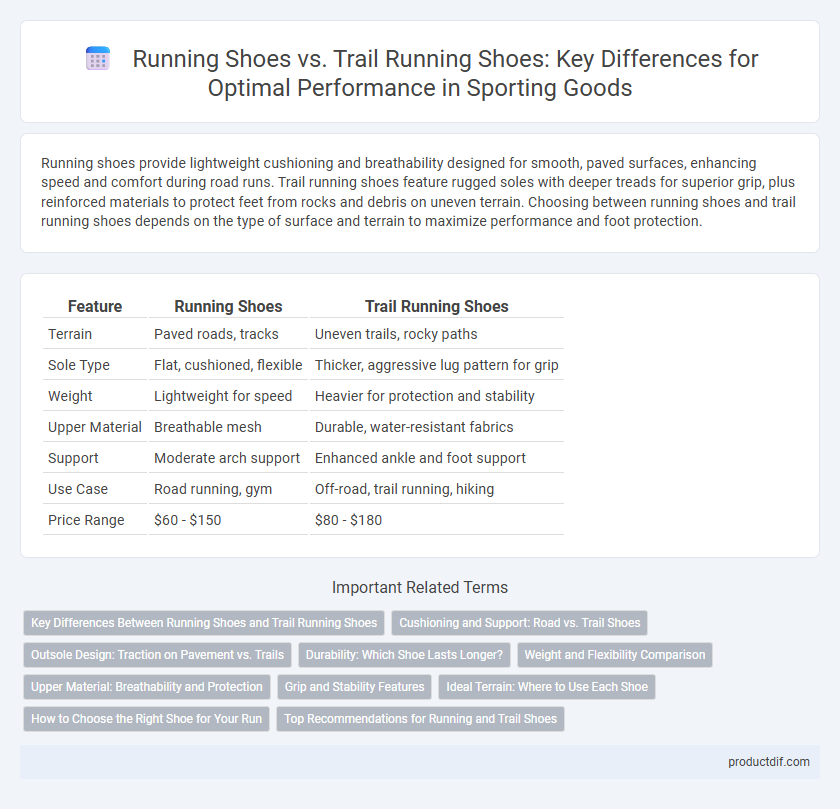Running shoes provide lightweight cushioning and breathability designed for smooth, paved surfaces, enhancing speed and comfort during road runs. Trail running shoes feature rugged soles with deeper treads for superior grip, plus reinforced materials to protect feet from rocks and debris on uneven terrain. Choosing between running shoes and trail running shoes depends on the type of surface and terrain to maximize performance and foot protection.
Table of Comparison
| Feature | Running Shoes | Trail Running Shoes |
|---|---|---|
| Terrain | Paved roads, tracks | Uneven trails, rocky paths |
| Sole Type | Flat, cushioned, flexible | Thicker, aggressive lug pattern for grip |
| Weight | Lightweight for speed | Heavier for protection and stability |
| Upper Material | Breathable mesh | Durable, water-resistant fabrics |
| Support | Moderate arch support | Enhanced ankle and foot support |
| Use Case | Road running, gym | Off-road, trail running, hiking |
| Price Range | $60 - $150 | $80 - $180 |
Key Differences Between Running Shoes and Trail Running Shoes
Running shoes are designed with lightweight materials and cushioning to enhance speed and comfort on smooth, paved surfaces, featuring flexible soles and breathable uppers. Trail running shoes prioritize durability and stability, equipped with rugged outsoles for superior traction on uneven, rocky terrain and reinforced toe caps for protection against obstacles. Additionally, trail shoes offer enhanced water resistance and support to handle varied outdoor conditions effectively.
Cushioning and Support: Road vs. Trail Shoes
Running shoes designed for roads typically feature lightweight cushioning optimized for repetitive, smooth surface impact, offering moderate support that prioritizes flexibility and responsiveness. Trail running shoes incorporate more robust cushioning systems with added durability, combined with enhanced support structures such as reinforced midsoles and aggressive outsoles to tackle uneven, rugged terrains. The distinct differences in cushioning density and support technology directly address the demands of road running's consistent impact versus trail running's unpredictable, multidirectional stresses.
Outsole Design: Traction on Pavement vs. Trails
Running shoes feature outsoles designed with smoother rubber compounds and shallower treads to optimize traction on pavement, enhancing grip and cushioning for repetitive road impact. Trail running shoes incorporate deeper, more aggressive lugs with durable, multi-directional tread patterns crafted from harder rubber to provide superior traction and stability on uneven, rocky, and muddy trail surfaces. The outsole design in trail running shoes prioritizes durability and grip on diverse terrains, while standard running shoe outsoles focus on flexibility and shock absorption for flat, hard surfaces.
Durability: Which Shoe Lasts Longer?
Trail running shoes typically offer greater durability than regular running shoes due to reinforced materials like tougher outsoles and protective toe caps designed for rough terrains. Running shoes often prioritize lightweight and cushioning, which can lead to faster wear on hard surfaces like pavement. The enhanced durability of trail running shoes makes them a better investment for runners frequently tackling uneven or abrasive environments.
Weight and Flexibility Comparison
Running shoes typically weigh less than trail running shoes due to their streamlined design focused on road surfaces, enhancing speed and agility. Trail running shoes incorporate sturdier materials and reinforced soles for durability and protection, which increases their weight but provides better stability on uneven terrain. Flexibility in running shoes is generally higher to allow natural foot movement, while trail running shoes prioritize support and rigidity to prevent injuries on rugged trails.
Upper Material: Breathability and Protection
Running shoes feature uppers made from lightweight, breathable mesh materials that enhance airflow and keep feet cool during road runs. Trail running shoes utilize more durable uppers with reinforced overlays and water-resistant fabrics to provide protection against rocks, mud, and debris on rugged terrain. The balance between breathability and protection in the upper material is a key differentiator tailored to the demands of road versus trail running environments.
Grip and Stability Features
Trail running shoes feature aggressive lug patterns and reinforced soles designed for superior grip on uneven, slippery terrains, providing enhanced stability during off-road runs. Running shoes prioritize smooth, lightweight outsoles optimized for pavement, offering less grip but more flexibility and cushioning for consistent road surfaces. Stability in trail shoes is augmented by rock plates and sturdier heel counters, while road running shoes focus on responsive cushioning and medial support for efficient forward motion.
Ideal Terrain: Where to Use Each Shoe
Running shoes are designed primarily for smooth, paved surfaces such as roads and tracks, offering lightweight cushioning and flexibility ideal for urban environments. Trail running shoes feature rugged outsoles with aggressive treads and enhanced stability, making them perfect for uneven, rocky, and muddy terrains found in forests and mountain trails. Choosing the right shoe depends on the terrain to ensure optimal traction, support, and injury prevention during runs.
How to Choose the Right Shoe for Your Run
Selecting the right running shoe depends on the terrain and type of run you plan to tackle. Running shoes offer lightweight cushioning and flexibility ideal for smooth pavement or treadmill workouts, while trail running shoes provide enhanced grip, stability, and protection suitable for rugged, uneven trails. Understanding your running environment and gait mechanics ensures optimal performance and injury prevention by matching shoe features to specific needs.
Top Recommendations for Running and Trail Shoes
Top recommendations for running shoes include models like the Nike Air Zoom Pegasus, Brooks Ghost, and ASICS Gel-Kayano, known for superior cushioning, breathability, and support on paved surfaces. Trail running shoes such as Salomon Speedcross, Hoka One One Speedgoat, and Altra Lone Peak offer enhanced traction, durable soles, and protective features tailored for rugged terrain and uneven trails. Selecting running shoes based on surface-specific technology improves performance and reduces injury risk for both road runners and trail enthusiasts.
Running Shoes vs Trail Running Shoes Infographic

 productdif.com
productdif.com